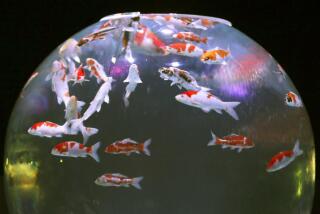It’s <i> the</i> Big Fish to Keep If You Have a Little Pond
- Share via
When fish fanciers recently gathered in Gardena, it was to separate the koi from the koi-polloi.
Making the biggest splash was a six-year-old kohaku (red and white) female, a 2 1/2-footer that bested about 500 others to swim away with the championship trophy.
It was the 20th anniversary show of the Southern California Chapter, Zen Nippon Airinkai. (That, in Japanese, means “friendship through scales.”)
Contestants, arriving in plastic bags, were released into big vinyl tanks that look for all the world like back yard kiddie pools. Judges moved from tank to tank, peering down at the fish and assessing them from tail to whiskers.
How do you tell a cool koi from a so-so koi? For that matter, a boy koi from a goil koi? It’s all about body shape and color patterns. Clean, well-defined splotches of color are good. Spattery--as in Jackson Pollock--is bad.
Just as Rorschach’s patients saw wondrous things in ink blots, the Japanese--who popularized the koi--see on the backs of the fish not blobs of color, but fanciful shapes such as Napoleon’s hat, cherry blossoms and Mount Fuji. They’ve gone so far as to name them accordingly.
The cream of the crop still come from Japan where, through years of inbreeding, the fish has mutated from a dreary but delicious dinner delicacy into a vividly colored and pricey pond pet.
As exhibitor Ben Plonski of Laguna Koi Ponds put it, “They all started out as mud carp, kind of grayish-green. Then, about 100 years ago, one guy popped up with a little red on him and, wow!”
Like Zen Nippon Airinkai chapter president Bob Estrella of Cerritos, people typically get hooked on koi the day they decide to pretty up their garden. So they dig a pond and buy a few goldfish--the koi’s less regal kissing cousins.
Before long, they find themselves forking over $200-$1,000 for a serious show circuit koi.
Judges put a $30,000 price tag on Gardena’s grand champion, bred in Japan and owned by Katsuji Nerio of Chino. But, unlike the master of a best-of-show dog, Nerio doesn’t stand to cash in with future generations. It seems that koi are genetically unreliable.
Estrella explains, “You breed two brown cocker spaniels, you get a brown cocker spaniel.” But two red and white koi might produce black or white or red koi.
Koi have other disconcerting habits, such as eating their young. But those that survive commonly live to 70 years old or so. A Japanese specimen is reported to have made it to 226. In that country, observed judge Jack Stone of Tucson, “they can depreciate them” on their tax returns.
Koi don’t mind cold water and are versatile eaters (fish pellets, veggies, Cheerios, whatever). What’s more, koi lovers will tell you, they are affectionate--they like to be petted and will swim over to nuzzle the hand that feeds them.
Apartment dwellers might note that koi can be kept in indoor aquariums. But, Plonski points out, those pretty patterns are meant to be admired from above. “They may look weird from the side.”
Because What Are Husbands for Anyway?
Monica Ballard of West L.A.-based Parallax Education, which gives seminars on sexual harassment in the workplace, passes along this nugget from a Fortune 100 client. It’s verbatim from the company’s 1930s employee manual:
“Married women are not to be employed, except
1. where their husbands are incapable of supporting them by reason of physical disability or mental incompetency, and
2. for temporary employment (a period not exceeding 6 months).
Further, the manual instructs, “Single women are to be notified at the time of their employment that their service will terminate within 60 days after their marriage.”
*
Scrawled on a jalopy pulling away from a curb in Santa Clarita: “ANYWHERE BUT HERE OR BUST.”






